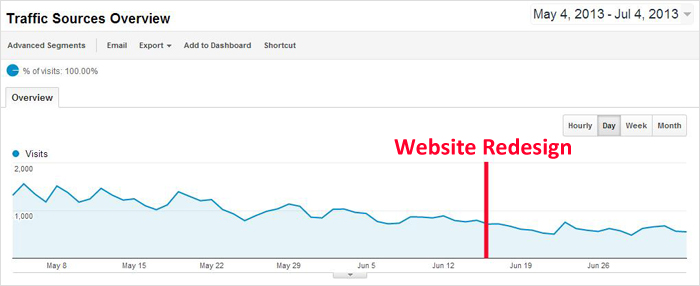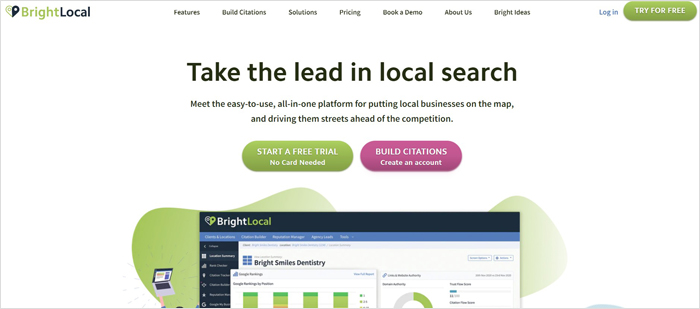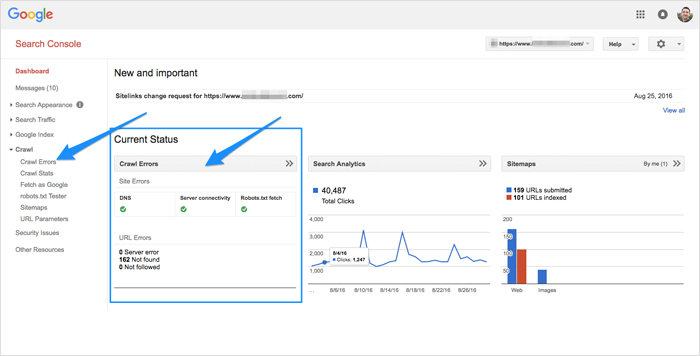Motivation for a website rebrand can be for one or more of the following reasons:
- Modernize the look, content & design
- Add new features or enhance existing website functionality
- Moving to a better, newly acquired domain or brand
- Business combination (and by extension website combination), including a merger or acquisition
- Improve SEO and website rankings
The good news is that there are ways to ensure that your SEO performance and rankings won’t be adversely affected when revamping a website.
With some know-how, careful planning, and adequate resources on your side, you can make a smooth and impactful transition to your new site.
Table of Contents
Why Consider SEO When Rebranding A Website?

75% of customers judge a company’s credibility based on their website design, making it imperative to focus on rebranding efforts from time to time.
Suppose your website is doing great. You have flowing organic traffic, rankings are strong, and your ROI is growing. Do you want to ruin all that hard work? Of course, you don’t.
However, strategic planning can help you leverage the opportunity to improve your website’s performance even after a redesign. If you redesign it right, you won’t lose any rankings or traffic. You’ll augment them.
SEO is a vital aspect to consider when rebranding your website. Here are some of the steps that can help you understand the new site dynamics compared to your existing site from an SEO standpoint.
Here are some of the steps you need to follow to rebrand your website smartly without compromising its SEO.
Step 1: Preliminary Work
Before we delve into the strategy, it is essential to make sure that you have all the necessary prerequisites needed to implement the right course of action at the right time.
Here’s what you’ll need:
- Google Webmaster Tools. Include and verify both the sites in Google Webmaster Tools to benefit from Google’s feature of Change of Address.
- Google Analytics. Check if you have admin access to the website in Google Analytics. If you don’t have the proper authorizations, you won’t be able to update the old website information and replace it with the new one.
- Registrar and Hosting. Confirm that you are an authorized user to host both the websites, the old and new ones. Additionally, ensure that you can host both the new and the old websites for the foreseeable future. The same is the case for your old domain name – you’ll need to register it for as much time as possible to maintain its control for the near future.
- Block the New Site. Your new site should be fully functional– but do not index it yet. This is imperative to avoid duplication content issues if the web pages are mostly similar to the old site. You can easily do this with the Robots.txt file.
- Back up. Last, of all, make sure you back up your old site. It’s better to be safe – in case you need it down the road.
Step 2: Benchmark Crucial KPIs

If you are in the marketing team or industry, you most likely make a point of gauging everything. But your analytical data becomes even more crucial while you are rebranding.
Take out the time to set the benchmark of your most critical SEO KPIs prominent to the transition. The following factors can be an excellent place to start with:
- Traffic. Divide it by channels such as referral, organic, direct, etc.
- Rankings. Position the document for the 20-30 most important keywords – containing both the old and new brand names.
- Links. Gather a list of all the backlinks – the websites that link to yours. Use our free link checker to do so.
- Citations. Backlink citations are the “mentions” of your previous brand in high authority sites online. You can record these by searching manually in Google, or you can leverage a tool like Yext or BrightLocal.
Step 3: Prepare For 301 Redirects
Ensure a seamless user experience and boost the search engine ranking by redirecting every web page from your old website to your new site’s appropriate section.
Although you need to create your redirects file at this stage, you don’t actually get to use it until you are prepared to take your new website live. The intricacies in this step highly depend on the specifics of your rebranding strategy.
Does Your New Site And Old Site Have The Same URL Structure And Pages?
You can easily route all the web pages from your old domain to the new website’s corresponding web page merely by using a couple of lines of coding in your .htaccess file.
Does Your New Site And Old Site Have Different URL Structure And Pages?
If you have different URL structure and pages on your new and old site, you’ll have to take a few additional steps. And if you have a site with lots of web pages (if you’ve been working on inbound marketing, you almost surely do), this step may take some time.
In this case, you still use the .htaccess file, but you’ll need to redirect every web page on your old domain to the most appropriate web page on the new site.
Some of the points to remember when redirecting the web pages from old domain to new domain:
- It’s easier to manage the entire procedure with a spreadsheet
- You can list the URLs for each web page on the old website in one column and then drop them in the corresponding URLs in the next column of the new website
- If you have content on a different subdomain hosted somewhere else, you will have to develop an individual .htaccess file for those particular URLs
Of course, web pages that generate site traffic or have backlinks need to be prioritized, so organize your worksheet accordingly to update these pages first.
Step 4: Deployment
Ready to execute the plan? It’s now time for all that hard work to pay off finally – this is the most straightforward step!
- First, upload the .htaccess file that you created to the old site hosting. Since the results will be instant, it’s a good idea to test various old URLs to make sure they direct to the right webpages on the new website. Also, remember to test drive the home page.
- Then, eradicate the command of Robots.txt on the new website that is blocking it from appearing on search engines.
Don’t be convinced to take down your old website too impulsively. Since DNS can take a few days to update, some audiences will continue to view your old website after setting up the redirect.
Taking down your old site too soon could result in a cluster of 404s – confusing your visitors and jeopardizing your website traffic.
Step 5: Update Google Webmaster Analytics And Tools

After you set up your 301 redirects, you’ll need to let Google know that you are relocating your website. Google Webmaster Tools has a versatile feature of change of address that you can use.
Typically, you’ll want to update the information in two places. First, under Account Settings, revise the Account Name field and under the Property Settings, update both the Default URL fields and the Property name.
You might also want to add an annotation in Google Analytics when you move your site so that you have a valid reference point when you want to compare the online traffic before and after you switch to the new site.
Step 6: Give The Search Engines Signals To Connect The Old And New Names
The search engines will ultimately figure out the correlation between your new and old company names, but you can also send those indicators to a number of locations to streamline the process.
Following are some of the different places that you can send signals to:
- Meta descriptions and title tags
- Descriptions and/or social media account handles
- A custom 404 page
- Guest blog posts on high-authority sites
Typically, “About Us” pages essentially include some data about an organization’s history, making them a suitable spot to mention your former brand name.
While “information scent” is vital for SEO efforts, it also helps your transition less perplexing for your site visitors.
For example, someone who looks for your previous brand name and ends up on an unknown website with a new name may be confused. Without proper information, it will just increase the churn rates.
Step 7: Keep Your Directory Listings Up To Date
If you own a local business, your brand should be highlighted in the local searches that include your products and services.
One of the influential local search engine ranking factors is your company NAP (Name, Address, Phone number) – across the scores of regional, industry, and local business directories. From an SEO standpoint, these are known as citations.
That said, you’ll need to revert and update each listing with your business’s new information. It may sound monotonous, but it is of paramount importance for your local SEO efforts.
Be mindful. This is not merely a one-time undertaking. As you advance, you’ll see that many directories take much longer to update the listing. Once it updates, it can be weeks before Google starts indexing the new information.
A well-ordered spreadsheet is an effective way to structure, document, and monitor your progress. Additionally, there are also a bunch of powerful tools that can take some of your grunt work out of the process.
Step 8: Do Link Update Outreach
Much like updating business directories, the backlink outreach component of the procedure is certainly going to take some of your time. Here, the primary goal is to get all the strong links that direct to your old website and/or mention your former name updated to the new data.
The initial step is to determine all the sites that have included a link to the old company name or have mentioned it. Fortunately, various tools allow you to streamline this process, including Majestic, Ahrefs, Open Site Explorer, etc.
Then, assemble all of those links into a database, eliminate the duplicate copies of the similar data sets, and start to work your way down the list. Using an email template, you can expedite the process, but a customized approach is ideal with all other outreach efforts.
Additionally, you can use the spreadsheet to maintain the updated brand mentions and links. And get in touch with the relevant person to follow up.
Step 9: Promote Your New Brand
Now, it’s time to put the word out about your new brand. If you do this successfully, you essentially end up with increased overall visibility and more traffic than before.
- Email announcement. Tell everyone – vendors, customers, friends, and suppliers. You want to get the target audience to search for your business with your new brand name and get to your new website
- Press release. Draft a compelling release that comprises your new brand’s story and send it out via a PR distribution platform. Include your former brand name and the updated NAP (name, address, and phone number) because the release will probably get picked up by various sites.
- Guest posts. You can pitch related blog posts with websites whose audience may be interested in and learn from your rebranding initiative. If you need help writing blog posts, just let us know (shameless plug).
- Social Media. Keep up with your social media platforms, update your profiles with new brand-related information and leverage them to put the word out about your new name. This is also an excellent time to invest in paid social campaigns to expand your reach
- PPC. If you did a great job promoting your old brand, your audience would most likely continue to search for it. Buy PPC ads for your former brand name and leverage the ad copy to spread the word and communicate the rebranding
Step 10: Monitor And Follow Up

Your work doesn’t end here. It is imperative to monitor the progress for the next few months and follow up with the relevant course of action. Here are some of the main areas to concentrate on:
- Directory listings. Since it takes a while for data providers to update your data, you are going to realize that listings still pop up with your old brand name. For that reason, you’ll have to periodically figure out, claim and bring the old listings up to date. This could continue for months, and it’s essential that you catch them at an early stage.
- Links. It will most likely take you a few outreach attempts to update your links to the new and recent brand information. It’s good to focus on getting the most crucial, relevant, and authoritative links updated first.
- 404s and crawl errors. Irrespective of how much preparation you do, these errors are inevitable. Fortunately, Google Webmaster Tools effectively monitors all of them for you. Keep an eye on the 404s (pages not found error) as they surface. It is essential to redirect them and then in GWT do “mark as fixed.”
- Rankings and traffic. Closely monitor the KPIs that you set as benchmarks in step 2. If you oversee a big difference in either your rankings or your traffic, dig deeper to figure out the problem. Expect to see your rankings improve steadily for your new brand name – the time it takes depends on the term’s competitiveness.
Initially, you might see a dip in your website traffic for a month or two while search engines are indexing all your updates. An exceptionally well-executed plan can lead to more visibility and more traffic.
In Conclusion
Rebranding and merging separate websites is a vast and essential endeavor as 88% of online customers don’t consider returning to a site after having a bad experience. The entire process requires input from all decision-makers within your organization.
You would want your customers to understand and recognize your efforts, and your website is the perfect way to showcase your new look. Promoting your rebranded website shows your company is assured in the new direction it took and owns the transformation.
All in all, building and retaining your online presence during the rebranding of your website process can provide optimal value to your business. Additionally, optimizing your website’s new brand elements for search engines is undoubtedly an enormous part of it.
All in all, it is vital to put effort into keeping your SEO rankings high throughout the process. We can help.
You need a partner, a full service SEO company that’s just as committed to generating profitable results for your business. We can help you reach your business goals for both website redesign and rebranding as well as improve your organic ranking through quality link building service. Get in touch with us today!
Tim holds expertise in building and scaling sales operations, helping companies increase revenue efficiency and drive growth from websites and sales teams.
When he's not working, Tim enjoys playing a few rounds of disc golf, running, and spending time with his wife and family on the beach...preferably in Hawaii.
Over the years he's written for publications like Forbes, Entrepreneur, Marketing Land, Search Engine Journal, ReadWrite and other highly respected online publications. Connect with Tim on Linkedin & Twitter.
- How to Rank for Local SEO in Multiple Locations - April 16, 2024
- SEO for Mass Tort Lawyers: Everything You Need to Know - April 3, 2024
- Natural Backlinks vs. Unnatural Backlinks: How to Build a Natural Link Profile - April 1, 2024




